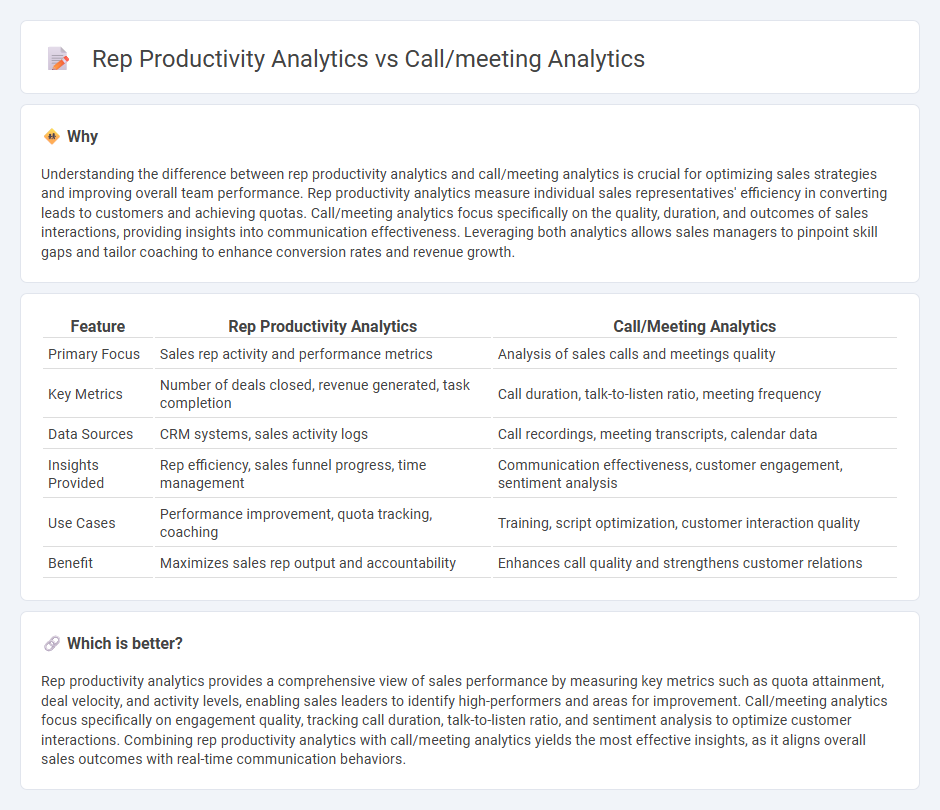
Sales rep productivity analytics focus on measuring overall performance metrics such as quota attainment, revenue generated, and time spent selling, providing a comprehensive view of individual effectiveness. Call and meeting analytics specifically analyze interaction quality by tracking call duration, talk-to-listen ratios, and meeting outcomes to optimize communication strategies. Explore these analytics to enhance sales team efficiency and drive revenue growth.
Why it is important
Understanding the difference between rep productivity analytics and call/meeting analytics is crucial for optimizing sales strategies and improving overall team performance. Rep productivity analytics measure individual sales representatives' efficiency in converting leads to customers and achieving quotas. Call/meeting analytics focus specifically on the quality, duration, and outcomes of sales interactions, providing insights into communication effectiveness. Leveraging both analytics allows sales managers to pinpoint skill gaps and tailor coaching to enhance conversion rates and revenue growth.
Comparison Table
| Feature | Rep Productivity Analytics | Call/Meeting Analytics |
|---|---|---|
| Primary Focus | Sales rep activity and performance metrics | Analysis of sales calls and meetings quality |
| Key Metrics | Number of deals closed, revenue generated, task completion | Call duration, talk-to-listen ratio, meeting frequency |
| Data Sources | CRM systems, sales activity logs | Call recordings, meeting transcripts, calendar data |
| Insights Provided | Rep efficiency, sales funnel progress, time management | Communication effectiveness, customer engagement, sentiment analysis |
| Use Cases | Performance improvement, quota tracking, coaching | Training, script optimization, customer interaction quality |
| Benefit | Maximizes sales rep output and accountability | Enhances call quality and strengthens customer relations |
Which is better?
Rep productivity analytics provides a comprehensive view of sales performance by measuring key metrics such as quota attainment, deal velocity, and activity levels, enabling sales leaders to identify high-performers and areas for improvement. Call/meeting analytics focus specifically on engagement quality, tracking call duration, talk-to-listen ratio, and sentiment analysis to optimize customer interactions. Combining rep productivity analytics with call/meeting analytics yields the most effective insights, as it aligns overall sales outcomes with real-time communication behaviors.
Connection
Sales rep productivity analytics leverages data from call and meeting analytics to measure key performance indicators such as talk time, engagement rate, and follow-up efficiency. Call and meeting analytics provide granular insights into customer interactions, enabling identification of patterns that impact conversion rates and sales cycle length. Integrating these analytics helps sales managers optimize coaching, resource allocation, and strategy adjustments to boost overall sales effectiveness.
Key Terms
**Call/Meeting Analytics:**
Call/Meeting Analytics provides detailed insights into conversation patterns, speech sentiment, and engagement metrics, enabling businesses to optimize communication strategies and improve customer interactions. It tracks key performance indicators such as talk-to-listen ratio, silences, and keyword usage to identify areas for coaching and enhance sales effectiveness. Explore how Call/Meeting Analytics can transform your sales conversations and boost overall performance.
Talk-to-listen ratio
Call analytics emphasize the talk-to-listen ratio to assess agent engagement and customer interaction quality during calls, highlighting how much time reps spend speaking versus listening. Rep productivity analytics use this ratio as one metric among others--such as call volume and resolution rates--to gauge overall efficiency and performance. Explore deeper insights into balancing communication metrics to boost both call effectiveness and representative productivity.
Sentiment analysis
Sentiment analysis in call and meeting analytics captures customer emotions and tone to gauge satisfaction and identify pain points, while rep productivity analytics uses sentiment data to evaluate agent communication effectiveness and training needs. By analyzing sentiment trends across interactions, businesses can optimize conversational strategies and improve overall customer engagement. Explore how sentiment-driven insights enhance both customer experience and sales performance.
Source and External Links
Use Call Analytics to troubleshoot poor call quality - Microsoft Teams Call Analytics provides detailed insights into call and meeting quality, device and network performance, and connectivity issues for individual users, helping admins identify and resolve problems affecting user experience.
Call Analytics: Gaining Key Insights from Calls - Dialpad's call analytics collects and analyzes caller demographics, contact center performance, and customer sentiment to optimize marketing, sales, and service strategies using AI-driven insights.
What is Call Analytics and How Does it Work? - Call analytics measures, collects, and reports call data--such as source attribution, call recordings, and transcriptions--enabling marketing, sales, and support teams to track performance and derive actionable insights.
 dowidth.com
dowidth.com